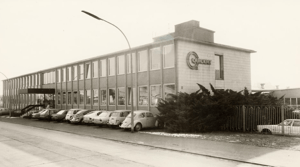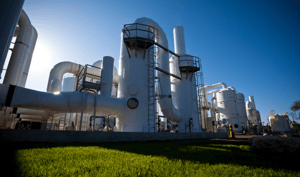The Modernization of Chemical Plants
 If you were a chemical engineering major in college like me, most of your time in school was probably consumed with writing lab reports, solving complicated math problems, and completing copious amounts of physics and chemistry homework. My curriculum did require a few humanity classes (I guess to diversify the repertoire of the engineering student’s workload), but little time was spent learning about the actual history of chemical plants. Don’t you think it would have been interesting to take a “Chemical Plants History” class?
If you were a chemical engineering major in college like me, most of your time in school was probably consumed with writing lab reports, solving complicated math problems, and completing copious amounts of physics and chemistry homework. My curriculum did require a few humanity classes (I guess to diversify the repertoire of the engineering student’s workload), but little time was spent learning about the actual history of chemical plants. Don’t you think it would have been interesting to take a “Chemical Plants History” class?
While the modernization that has occurred in the past decade is, of course, the most relevant to us, I think it’s also useful for today’s engineer to know how plant technology has evolved. I even find that working with engineers who graduated in the 50’s, 60’s, and 70’s brings a different perspective, when comparing what they’ve experienced as young engineers working at a plant versus my own personal experience. So, let’s start with a quick history lesson.
The Evolution of Chemical Plants
We have all heard of the industrial revolution. What came as a surprise during my research was to learn that Sulfuric Acid was one of the first chemicals to be produced in large quantities through an industrial process.
By the 19th century, there was an impressive expansion in this field, especially in the United States and Germany. Manufacturing of artificial agricultural products, as well as dyes, represented most of the chemical market in the early decades of the 19th century[1]. Companies like Bayer, BASF, and Hoechst (now a subsidiary of Sanofi-Aventis) saw their start in this century. With a demand in plant development and plant construction there was a need for equipment providers. It was at this time, in approximately 1871 that De Dietrich’s factory in Zinswiller, France became specialized in the manufacture of iron enameled equipment to be used for the chemical industry, laboratories, dye works, and pharmacies[2].
In the late 1800's in the United States the chemical industry grew, in many ways thanks to Mr. Herbert Henry Dow (founder of the Dow Chemical Company). He was a pioneer in electrochemistry, which included the development of a more affordable method to extract bromine from brines, and also made a big investment in the manufacturing of chlorine[3].
By the early 20th century, companies opted to consolidate into large conglomerates to help diversify their portfolios; they also continued to invest in new technology.
Around this time, a new breed of engineering services grew. Engineers who had worked for larger companies would venture off and start their own consulting firms, bringing with them part of the knowledge from their earlier career experiences. Engineering consulting and services became an attractive option for large chemical companies. New process technologies would be developed outside of these large conglomerates, creating a win-win situation.
While the owners of chemical plants would focus their workforce on the manufacturing and production of chemicals, as well as researching new chemistries, a smaller team within the company would work with outside engineering firms to create more efficient processes, buy new technologies, and expand plants from these outside firms.
By the mid-20th century, the chemical industry faced new challenges around improving the safety of their production facilities. Preventing serious industrial accidents, including explosions, reducing exposure to harmful chemicals and addressing growing environmental concerns drove plants to undergo constant monitoring and improvements. These demands for higher safety and lower environmental impact are still valid today.
Reducing Risks in Chemical Plants
 With a brief history of chemical plants under our belts, we can now focus on plant modernization in today’s world. The three main benefits of modernizing plants include: improving safety on old processes while extending useful plant life, increasing throughput and efficiency (reducing energy consumption), and retro-fitting existing facilities for new processes (change in feedstock composition). Let’s break down each advantage:
With a brief history of chemical plants under our belts, we can now focus on plant modernization in today’s world. The three main benefits of modernizing plants include: improving safety on old processes while extending useful plant life, increasing throughput and efficiency (reducing energy consumption), and retro-fitting existing facilities for new processes (change in feedstock composition). Let’s break down each advantage:
1. Improving safety while extending useful plant life
Operating procedures should be reviewed to identify any potential safety issues that may arise from old/outdated practices. A plant owner can significantly reduce risks in their existing plants by reviewing and updating operating procedures, while also providing continuous training to employees and operators. Doing this analysis may allow owners to reduce or eliminate risks by updating certain components of a process without having to replace the entire train. Design improvements that addressed common safety concerns were likely developed in the years since the original equipment was installed and commissioned.
The next step should be to look at upgrading current instrumentation. Instrumentation plays a key role in the safety of a chemical plant. Depending on the process, some clients have moved towards installing redundant instrumentation, especially when dealing with hazardous chemicals. A more hands-off approach to running plants can also create a safer environment for workers. Eliminating the need for operators to go outside the control room to read specific parameters or check levels through sight glasses helps to keep personnel at a safe distance from any potential hazards (although this is still a very popular way to check inventory on vessels and columns). In addition, it reduces the risks from human error.
2. Increasing throughput and efficiency while reducing energy consumption
Many companies are looking to increase the throughput of their existing plants. This can often be accomplished by evaluating the existing process and identifying bottlenecks. Sometimes simple changes, like a change in column packing or other column internals can bring a significant increase in throughput. Other times replacing instrumentation with newer, updated versions that provide wider ranges of measurement can do the trick. It is important to work with a team who not only has experience with designing efficient plants and optimizing processes, but who is also up-to-date on the latest technologies available.
3. Retro-fitting for new processes or change in feedstock composition
As technology providers, we understand the fast-evolving demands of the chemical market. Due to globalization, some products may face new competitive pressures that make existing processes less commercially attractive. In this case, if a plant is in good condition, clients often look at alternative products to be processed in existing equipment. The advantage of this approach is that by applying a series of small modifications and improvements, a new feed can be processed through the same equipment. This is a very attractive option for many clients. It reduces overall plant down time due to construction and most of the project will be executed without interruption of daily activities. It also reduces cost, as most of the equipment already exists on site.
A trend we have also recently seen is the relocation of processes to new sites. It is always good to check with the original manufacturing or engineering services provider, when possible, to make sure the equipment is disassembled and reassembled properly.
Modernizing procedures is an easy and low-cost way to improve safety, not just in chemical plants, but in other aspects of chemical processing. By identifying bottlenecks that are impeding the efficiency of your plants, replacing outdated instrumentation with state-of-the-art technology, and making small upgrades and improvements to your major pieces of equipment, you can not only improve the safety of your plant, but also see a significant increase in throughput. And if your process is no longer lucrative, try researching how to use your existing equipment to process new feeds.
De Dietrich Process Systems can help you to modernize your existing plant or define the process specifications for a new one. To find out how DDPS can help with your next project contact us or fill out our Process System Questionnaire.
[1] https://en.wikipedia.org/wiki/Chemical_industry#cite_note-6
[2] HAU, Michel, “The House of De Dietrich from 1685 to the present day”, p.89
[3] https://www.dow.com/en-us/about-dow/dows-growth-story/herbert-h-dow
